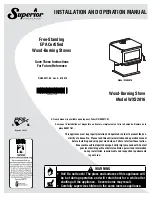
4
NOTE: DIAGRAMS & ILLUSTRATIONS ARE NOT TO SCALE.
TESTING INFORMATION
This manual describes the installation and operation of these non-catalytic
wood heaters. These heaters meet the U.S. Environmental Protection
Agency’s emissions limits, and are compliant with 2020 Cordwood
Standard. These heaters have been developed, tested and constructed
in accordance with the requirements of UL 1482, ULC S627 and HUD
standards and are listed by PFS Corporation. These heaters have been
approved for residential and mobile home installations.
Model
Emission
Rate
EPA Test Range
BTU/hr
Max. Output
BTU/hr
Efficiency
WXS2016 2.1 g/hr
16,000 – 42,600
55,600
70.0%
DRAFT REQUIREMENTS
This appliance is dependent upon a properly functioning chimney for
optimum performance. It is a high efficiency appliance that loses much
less heat up the chimney than older appliances and fireplaces. For this
reason it is important to match the stove to the chimney. The chimney
has two functions:
1. It draws combustion air into the appliance (without air, no fuel will
burn) and
2. It exhausts combustion by-products. Your new appliance is what is
known as a “natural draft” appliance.
The appliance depends solely on the natural draft of the chimney system
to draw combustion air into the unit. Draft is the force that moves air
from the appliance up into the chimney. The amount of draft in your
chimney depends on the length of the chimney, local geography, nearby
obstructions and other factors. Too much draft may cause excessive
temperatures in the appliance (overfiring). Slow or inadequate draft equals
poor combustion and possible smoking problems.
* Default - Category rating as assigned by the EPA. The estimated efficiency is
as follows: 63% (non-catalyst equipped), 72% (catalyst-equipped), and 78%
(wood pellets). See § 60.536(i)(3) at www.epa.gov.
WARNING
This product can expose you to chemicals includ-
ing Carbon Black, which is known to the State of
California to cause cancer, and Carbon Monoxide,
which is known to the State of California to cause
birth defects or other reproductive harm. For more
information go to www.P65Warnings.ca.gov
The following are some conditions that may contribute to poor chimney
draft:
1. A chimney too large for your appliance.
2. A chimney with not enough height to produce adequate draft.
3. A chimney with excessive height (this may allow exhaust to cool too
much before exiting, which will stall the rate the exhaust exits).
4. Offsets in the venting system are too restrictive (see Chimney Guide-
lines).
Inadequate draft will cause the appliance to leak smoke into the room
through the stove and the chimney connector joints.
Excessive draft may cause an uncontrollable burn or a glowing red stove
or chimney part.
Overfiring Damage
- If the heater or chimney connector glows, you are
overfiring. Other symptoms may include: Cracking, warping or burning
out of components, stove glass may develop a haze, which will not come
off with cleaning.
Overfiring of a stove is a condition where excessive temperatures are
reached, beyond the design capabilities of the appliance. The damage
that occurs from overfiring is not covered under the manufacturer’s
limited warranty.
Also see Troubleshooting on
Page 23
.
SELECTING THE PROPER VENTING SYSTEM
The appliance is merely one component of a larger system. The other
equally important component is the venting system. This is necessary for
achieving the required flow of combustion air to the fire chamber and for
safely removing unwanted combustion by-products from the appliance.
If the venting system’s design does not promote these ends, the system
may not function properly. Poorly functioning venting systems may create
performance problems as well as be a safety hazard.
A draft test should
read greater than .04’ W.C. (inches water column) and less than .08”
W.C
. As per NFPA-211 standard (see paragraph below), the installer
must take into account all variables within the installation and install the
appliance in such a manner that satisfies the draft requirements of the
appliance. See Chimney Guidelines below to assist you in selecting the
proper venting system for your installation.
American National Standards Institute ANSI/NFPA 211, Standard for
Chimneys, Fireplaces, Vents, and Solid Fuel-Burning Appliances - See
Draft Section:
A chimney or vent shall be so designed and constructed
to develop a flow sufficient to completely remove all flue and vent gases
to the outside atmosphere. The venting system shall satisfy the draft
requirements of the connected appliance in accordance with the manu-
facturer’s instructions.
Chimney Guidelines:
• This appliance requires approximately 12 feet minimum of “effective
draw” provided by the venting system. As a rule of thumb, every 90
degree total direction change in the venting will result in a loss of
approximately 5 feet of “effective draw.” Example: If two 45 degree
offsets are used, subtract 5 feet from the actual vertical vent height
to determine your “effective draw.” In this case if you had 14 feet of
vertical vent, the effective draw would only be approximately 9 feet
(14 ft. - 5 ft. = 9 ft.), therefore it may be necessary to add additional
height to the venting system.
• Do not install an offset within the first two feet above the flue outlet
on the appliance.
• In well insulated and weather tight homes, it may be difficult to es-
tablish a good draft up your chimney. The poor draft is caused by a
shortage of air in the house. In this situation an Outside Air Kit may
need to be installed (See Negative Pressure Warning on
Page 5
and
Outside Combustion Air on
Page 12
).
25. Do Not Overfire – If Heater or Chimney Connector Glows,
You Are Overfiring.
26. DO NOT CONNECT THIS UNIT TO A CHIMNEY FLUE
SERVING ANOTHER APPLIANCE.
27. DO NOT BURN GARBAGE OR FLAMMABLE FLUIDS SUCH
AS GASOLINE, NAPHTHA OR ENGINE OIL.
28. This wood heater has a manufacturer-set minimum low
burn rate that must not be altered. It is against federal
regulations to alter this setting or otherwise operate this
wood heater in a manner inconsistent with operating
instructions in this manual.





































